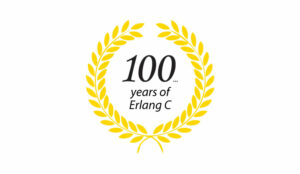The Erlang C formula is now 100 years old and it is still the basis of many calculations in the business world, especially in contact centres!
In 1917, A. K. Erlang published (in Danish) his landmark paper: “Solution of some problems in the theory of probabilities of significance in automatic telephone exchanges,” which included the following formula:
The Erlang C formula was originally designed for telephone switchboards, to calculate wait times as calls travelled through old-fashioned landlines.
However, it is a formula that is now primarily used as part of the Erlang Calculator, which helps to determine how many staff are needed in the call centre at any given time.
Using the Erlang formula, the Erlang calculator takes incoming call rate, average call duration and a time range into consideration, to produce the number of advisors that should be ready to answer calls in the contact centre.
This is all calculated to a contact centre’s preferred service level, which is traditionally to answer 80% of calls in 20 seconds.
However, recent versions of the Erlang calculator can also take maximum occupancy (the percentage of time that advisors are on the phone) and shrinkage (the percentage of time that an advisor cannot answer the phone) into account.
Nevertheless, Agner Krarup Erlang’s formula is still central to this process. This is despite it being over 100 years since his work was first published in Electroteknikeren in Denmark and the Post Office Electrical Engineers Journal in the United Kingdom.
Although it may no longer be used for its original purpose, Erlang’s work is still an integral part of the call centre industry.
To find out more on this subject, read our article: What Is an Erlang Calculator?
Author: Robyn Coppell
Published On: 11th Dec 2017 - Last modified: 26th Feb 2025
Read more about - Expert Insights, Erlang Calculations
















